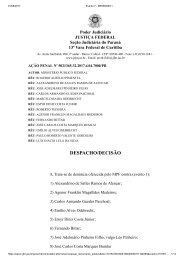Brasil só deve dominar Leitura em 260 anos, aponta estudo do Banco Mundial Relatorio Banco Mundial _Learning
Create successful ePaper yourself
Turn your PDF publications into a flip-book with our unique Google optimized e-Paper software.
financial support in anticipation of the increase in<br />
government funding. 25 Reducing the financial burden<br />
on parents may be a desirable effect of these grants,<br />
but it was not their primary intent. More generally,<br />
many factors outside the classroom and the school<br />
syst<strong>em</strong>, including health and economic shocks, can<br />
alter the impact of interventions aimed at improving<br />
learning. Failure to learn and adjust policies in<br />
response to such changes often means that interventions<br />
<strong>do</strong> not work as planned.<br />
Education syst<strong>em</strong>s are “sticky”<br />
Education syst<strong>em</strong>s are slow to change. Some of the<br />
best-known successes in reforming syst<strong>em</strong>s, such as<br />
in Chile or Finland, took decades from initiation to<br />
fruition. Even at the micro level, such as in schools<br />
in the United States that enacted comprehensive<br />
school reform, it took 8–14 years for the full effects to<br />
be felt. 26 These long time frames present two further<br />
challenges to better aligning education syst<strong>em</strong>s with<br />
learning. First, to improve learning, policies usually<br />
have to r<strong>em</strong>ain relatively consistent. This is difficult<br />
under normal circumstances: changes in government,<br />
volatile funding, and shifts in the overall economic<br />
context all threaten the sustainability of policies. 27 But<br />
staying the course is even more challenging when<br />
the reforms fail to show any benefits in the short<br />
run. Second, the long lags make program evaluation<br />
more difficult, because attributing improv<strong>em</strong>ents to<br />
specific interventions is especially challenging when<br />
their impacts <strong>em</strong>erge only in the long run.<br />
Impl<strong>em</strong>entation capacity to improve<br />
learning at scale is often lacking<br />
Opacity and stickiness make technical alignment hard<br />
enough to achieve; weaknesses in impl<strong>em</strong>entation<br />
capacity make the task even more daunting. Successful<br />
impl<strong>em</strong>entation depends on effective leadership,<br />
coordination between education agencies, and impl<strong>em</strong>entation<br />
teams that are motivated, use resources<br />
efficiently, and can troubleshoot in real time—all of<br />
which are in short supply in many syst<strong>em</strong>s. Moreover,<br />
behavioral economics highlights many cognitive pitfalls<br />
that policy makers commonly face in complex<br />
operating environments. These include difficulty in<br />
evaluating policy effectiveness when faced with too<br />
many options; loss aversion, or the tendency to feel<br />
failures more intensely than successes, which makes<br />
policy makers wary of experimentation; biases that<br />
lead to selective use of information to reinforce existing<br />
views; and relational bias, which makes it harder<br />
for officials with elite educational backgrounds to<br />
grasp the challenges of mass education. 28<br />
Education agencies often lack the capabilities<br />
needed to deal with these complexities. 29 A recent<br />
assessment shows how multitasking and fragmentation<br />
within education agencies can blur lines of<br />
accountability for learning. In Cyprus, because of the<br />
absence of a department for human resources and<br />
general administration, pedagogical departments had<br />
to manage these responsibilities, diverting time from<br />
<strong>deve</strong>loping programs and policies. 30 Public expenditure<br />
and financial accountability assessments also<br />
highlight the low capacity in many <strong>deve</strong>loping countries<br />
in key areas. For example, only about half of the<br />
72 low- and middle-income countries assessed since<br />
2010 had any syst<strong>em</strong> in place to ensure that resources<br />
intended for schools, health clinics, and other service<br />
delivery units reached the front lines. 31<br />
* * *<br />
Technical challenges and lack of impl<strong>em</strong>entation<br />
capacity result in misaligned education syst<strong>em</strong>s.<br />
When countries are unable to overcome these challenges,<br />
their education syst<strong>em</strong>s deliver levels of learning<br />
far below what is possible. But tackling the technical<br />
barriers to better learning is only part of the battle.<br />
To break out of low-learning equilibriums, countries<br />
must also address the political constraints that are<br />
often at the heart of these technical misalignments.<br />
Notes<br />
1. Duflo, Dupas, and Kr<strong>em</strong>er (2015).<br />
2. Bold and others (2013).<br />
3. Ac<strong>em</strong>oglu (2010).<br />
4. Béteille and Ramachandran (2016); Bruns, Filmer, and<br />
Patrinos (2011); Duthilleul (2005).<br />
5. Hallak and Poisson (2007); Transparency International<br />
(2009).<br />
6. Ministry of Finance, Bangladesh (2017).<br />
7. World Bank (2010).<br />
8. World Bank (2015b).<br />
9. See DISE website, http://udise.in/.<br />
10. OECD (2016); UIS (2017).<br />
11. Rajkumar and Swaroop (2008); Suryadarma (2012).<br />
12. Muralidharan and others (2017).<br />
13. Pritchett and Filmer (1999).<br />
14. Bruns and Luque (2015); Finan, Olken, and Pande (2015).<br />
15. Glewwe and others (2011); OECD (2009).<br />
16. World Bank (2015a); Reboot (2013).<br />
Education syst<strong>em</strong>s are misaligned with learning | 179








